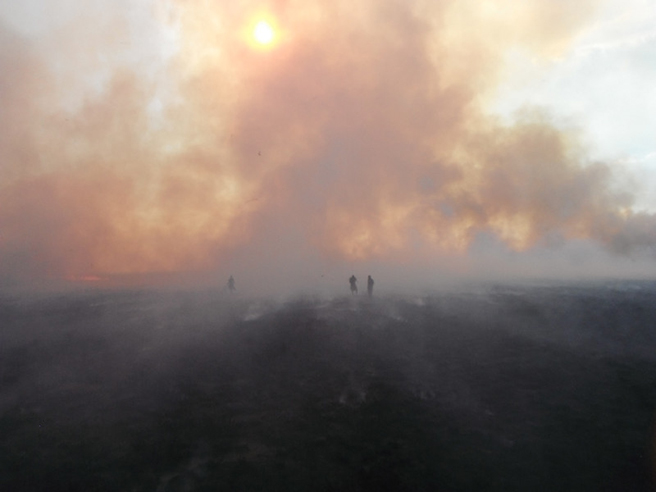Bush Fire in Chyulu

One of the best and worst things about living in Africa as an expatriate is the speed at which the unexpected happens. Just going to the shops, out of nowhere I was faced with a tribunal of very young Muslim girls curious about Muzungus (white people). They had lots of the kind of questions that only children have the innocence to ask, such as am I hairy all over and if they rub my skin will it turn theirs white. Occasionally these random riptides in the flow of your day evolve rapidly into what I can only describe as adventures. In the fall, I had one of these adventures that makes Africa for me.
I had gotten a bit sick of being in Nairobi, being a wilderness man, and so I had managed to persuade the anti-poaching organisation Big Life to let me join their rhino team on an anti-poaching patrol in Chyulu hills. These are in our Kilimanjaro heartland in the south of Kenya. They are the rolling hills that quietly and smoothly erupt from the edge of the Amboseli plains. In front of them are flat plains rolling far beyond where the eye can see and behind them are the mountains that make up the Tsavo West National Park.
To get there I took a Matatu, an adventure in itself which involves walking through what I can only think of as the “bus district” of Nairobi. Here you can get a bus to seemingly anywhere in Africa and there are more routes than I can begin to comprehend. Helpfully about 1 in 5 bus touts will tell you their bus goes where you want to go whether it does or not in order to get more custom. Anyhoo I got the right bus.
When I arrived in Mbrikani I couldn’t get through to my contact to get a lift so I wandered over to the nearest food house (If you haven’t been to one in Africa they are hard to describe, I’ll digress and talk about these another time). The Masai there were highly curious to meet a muzungu who speaks Swahili so within about half an hour I had found someone with a bike willing to drive me an hour across the plains to the lodge. His bike had a radio strapped to the front blaring out reggae which made for the most surreal bush drive I’ve ever been on.
When I got there my contact wasn’t there but I met a very friendly man named Wilson who I had made friends with on a previous visit. He told me that they had just had reports of a bush fire and were going out to fight it. Within about 5 minutes of arriving I was in a pickup filled with Masai herdsmen rocketing down dirt tracks to get to the fire. When we arrived it became rapidly clear that the fire was huge. We drove around a bit to get an idea of where we could fight it and then we all piled out of the car. Everyone pulled out their pangas (Machetes) and started cutting Acacia branches. It took me a few seconds to realise that the method of fighting fires out here is to hit it with incredibly spikey and importantly, flammable, bushes. Waving the herbaceous equivalent of porcupines around your head is dangerous enough as it is without being surrounded by people doing the same thing whilst everything is on fire.
After about 3 minutes of this I learnt my first important lesson about bush fires. The wind changed and suddenly blew very strongly in the opposite direction, the direction that we had come from and more importantly, left the car in. When the wind is low the fires don’t come much above 2-3 foot high and don’t move particularly fast. When the wind picks up it moves faster than running speed and the flames are 8-10 foot high. Fortunately the driver had learnt this lesson some years prior and managed to get the car started and turned around in time. He perhaps hadn’t learnt the lesson as well as he could have however as the fire consumed the bush we had parked next to about 3 seconds after the car escaped.
What followed was a crazy afternoon of fighting the fire, falling back when the wind changed, getting lost in smoke and general chaos. As the sun set we stopped the fire by lighting smaller fires along a road (a firebreak) and keeping them under control. The Masai are naturally a photogenic people but an image that will stay with me is the lines of tall, straight backed men decked out in bright red holding acacia branches lit up by the light of the sunset hitting the gusting smoke.
Once the main fire was beaten we went into the hills to beat out surviving patches. One of the quirks of fires in hills is the protection from the wind causes pockets to burn at different rates and thus survive semi dormant. By this time there were quite a lot of us and we set off up the incredibly steep hills to hunt down the patches.
It was like another world. I found myself walking through the curves and crests of the hills in pitch black, the plains lit up by the eerie light of fire on hillsides and the air filled with the calls, warnings and banter of the Masai against the white noise of the fire crackling. My memories of the night are a blur of vivid images; silhouettes of tall men against fire in the darkness, clouds of fleeing locusts appearing as black specks against the light, a crowd of people standing round a huge burning tree, half waiting for it to die down, half using it as an excuse to rest. Probably my strongest memory is the flickering combination of voices, laughter and shadows as the hilly landscape did strange things to the noise and light.
For me this was an adventure, for the herdsmen this was a regular job made enjoyable by banter and camaraderie.
